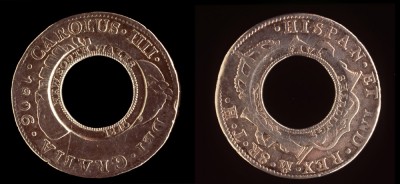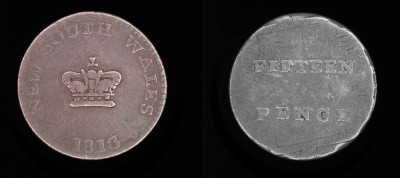Era: 1790 - 1830 Collection: Powerhouse Museum Theme:Settlement
Collection
Powerhouse Museum, Sydney, Australia.
Object Name
Holey Dollar and Dump.
Object description
Holey dollar, silver, Charles IV, Mexico Mint, 1806. Restruck in, New South Wales, 1813. Currency by Governor Macquarie’s Proclamation, 1 July 1813.
Circular disc with centre stamped out with the original Spanish details remaining on both sides, and the inner circle edges are over stamped with Australian markings. Obverse has a bust of Charles IV facing right, just visible on either side of the central void. On the reverse is a Spanish shield with swathed columns, just visible on either side of the void. Dimensions: Holey Dollar 37mm diameter and Dump 19mm diameter.
When the penal colony of New South Wales was founded 1788 there was no plan for a market economy to develop so no preparations were made for a New South Wales currency. But as soon as the colony started to expand and flourish with emancipated convicts and settlers taking up land, growing crops and buying supplies it ran into the problem of a lack of British coins. So New South Wales began trading in promissory notes (IOUs), land and rum. The officers of the New South Wales Corps had dominated the colony through corruption and subversion for 18 years and were behind this trade. Despite the efforts of Governors King, Hunter and Bligh to control their traffic in spirits and land they had become very wealthy and influential. Because farmers and labourers were being paid in rum alcoholism was rife and the colony was in an almost permanent state of drunkenness and debauchery.
In 1813 the new Governor Lachlan Macquarie overcame this problem by purchasing £10,000 in Spanish dollars to produce money to stabilise the New South Wales economy, wipe out rum and widespread drunkenness and wrestle control back from the elite from members the New South Wales Corps.
These coins to the value of 40,000 Spanish dollars came on the 26 November 1812 on the merchant ship the Samarang. To stop the coins leaving the New South Wales the centres were punched out to create two different issues of coins.
These two new coins were termed the ‘Holey Dollar’ which was valued at five shillings and the ‘Dump’ valued at fifteen pence. This doubled the number of coins in circulation and increased their total worth by 25 per cent. The work was carried out by William Hanshall, a convict transported for forgery.
The dump was restruck with a crown on the front and ‘Fifteen Pence’ on the reverse while the Holey dollars were re stamped around the hole with “New South Wales 1813″ on the front and “Five Shillings” on the reverse. The Holey Dollar became the first official currency produced specifically for circulation in Australia.
From 1822 these coins began to be recalled and replaced by sufficient sterling coinage. There are estimated to be 350 Holey dollars and 1500 dumps remaining in circulation today.
The Holey Dollar has historical significance as Australia’s first official currency thus signalling the British Government’s shift in policy from New South Wales as a penal outpost to a preference for a free market liberal colony. It is evidence of Lachlan Macquarie’s and the British Government’s intention to stamp out the rum trade and curb the illegal activities of the New South Wales Corp.
The Holey Dollar has intangible significance to Australians as an a symbol of Australia’s brutal convict origins, the renowned corruption of the New South Wales Corps and the early development of Australia’s economic system.
The Holey Dollar has interpretative significance in the presentation of the story of the early nineteenth Australia, the foundation of Australian political culture and economy, role of entrepreneurs and corruption in the establishment, survival and eventual expansion of the early colony at New South Wales. It also interprets an episode in the evolution from the brutal convict origins of European Australia to a migrant based market based economy.
Bibliography
Coupe, S & Andrews, M 1992, Was it only Yesterday? Australia in the Twentieth Century World, Longman Cheshire, Sydney.
Heritage Office & Dept of Urban Affairs & Planning 1996, Regional Histories of NSW, Sydney.
Heritage Collections Council 2001, Significance: A guide to assessing the significance of cultural heritage objects and collections, Canberra.
Hughes, R 1987, Fatal Shore, London.
Websites
Written by Stephen Thompson
September 2011
Migration Heritage Centre NSW 2011©





